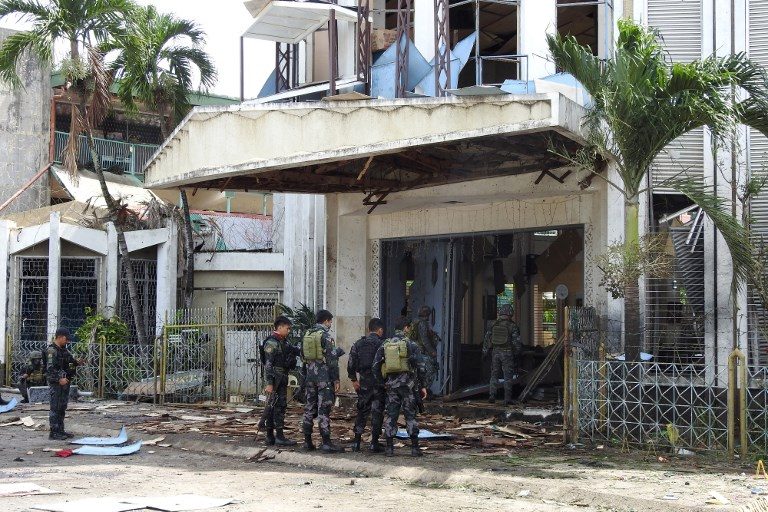SUMMARY
This is AI generated summarization, which may have errors. For context, always refer to the full article.

MANILA, Philippines – The recent Sunday blast in Indanan, Sulu, by an alleged suicide bomber came 3 days before the world commemorates the 9/11 attacks in the US on Wednesday, September 11.
Despite local and international efforts to address the threat, terrorism persists – and the Philippines remains to be very much a part of the global terror network.
Here are some facts about the growth of terrorism here.
Groups behind the attacks
Numerous terror groups have been known to operate primarily in Mindanao. These include:
- Abu Sayyaf Group (ASG) – The homegrown ASG, which eventually got linked to al-Qaeda, mounted its first major attacks in 1991. In the early 2000s, it became notorious for high-profile bombings, assassinations, and kidnappings. It was founded in Basilan and has since expanded to other provinces in Western Mindanao such as Sulu and Zamboanga.
- Maute Group – Led by Abdullah Maute, eldest of the Maute family brothers, this group was responsible for several attacks in Lanao del Sur before the Marawi siege in 2017. It pledged allegiance to the Islamic State in 2015, according to the Terrorism Research and Analysis Consortium.
- Jemaah Islamiyah (JI) – al-Qaeda’s network in Southeast Asia. Analysts estimated its active membership to be between 2,000 to 3,000 in 2018. Some members of the mainstream Moro Islamic Liberation Front (MILF) were known to have had ties with JI.
- The Bangsamoro Islamic Freedom Fighters (BIFF) – A breakaway of the MILF that’s now at the helm of the newly formed Bangsamoro Region, the BIFF has pleged allegiance to ISIS and has been behind violent incidents in Central Mindanao.
Even before the 9/11 attacks, the Philippines was already witness to terror. Below is a list of some of the biggest terror attacks that have occurred in the country before the administration of President Rodrigo Duterte:
| Event/Location | Date | Killed | Wounded |
|---|---|---|---|
| Rizal Day Bombings | December 30, 2000 | 22 | 100~ |
| General Santos City | April 21, 2002 | 13 | 60~ |
| Zamboanga City | October 2, 17, 21, 2002 | 23 | 100~ |
| Davao International Airport | March 4, 2003 | 22 | 143 |
| Koronadal City | May 10, 2003 | 10~ | 42~ |
| General Santos City | December 12, 2004 | 14+ | 70~ |
| SuperFerry 14 bombing | February 27-28, 2004 | 116 (presumed) | – |
| Valentine’s Day Bombings in Davao, Makati, GenSan | February 14, 2005 | 8~ | 147~ |
| subsequent Mindanao bombings | July 4, 5, 7, 2009 | 13 |
91 |
| Basilan raid | February 27, 2010 | 0 |
26 |
| Total | 241 | 779 |
Sources: GMA News, PhilStar (1, 2, 3), Human Rights Watch (1, 2), Philippine Senate, Al Jazeera
Extremist groups, mainly the ASG, MILF, and JI have claimed responsibility for these attacks.
Mindanao suffered – and continues to suffer – the most from terror.
From 2000 to 2012, the region witnessed 25 bombing and grenade attacks. Soccsksargen, the Autonomous Region in Muslim Mindanao (now replaced by the larger Bangsamoro Autonomous Region in Muslim Mindanao or BARMM), and Zamboanga had the deadliest bombing attacks during this period. (READ: Mindanao bombs: over 300 killed in 12 yrs)
Even President Rodrigo Duterte’s hometown has not been spared, as shown by the Davao night market bombing in 2016. Fourteen were killed and 60 were injured.
In Basilan last year, a foreigner blew himself up in Lamitan City, killing at least 10.
This year, on January 27, the Cathedral of Our Lady of Mount Carmel in Jolo was bombed by an Indonesian couple. The blast killed at least 23 people and left more than 100 injured.
On June 28, the police and military confirmed the “first suicide bombing by a Filipino” in Sulu.
Marawi siege impact
It is the 2017 Marawi siege however that has had long-term consequences. The instability that followed prompted Duterte to implement martial law in Mindanao.
The battle of Marawi is the Philippine military’s longest and bloodiest in recent history, running for 5 months. The Maute Group even trained children to fight.
According to the United Nations High Commissioner for Refugees, 353,921 families were displaced at the height of the siege.
Many of the 2,261 deaths in the BARMM in 2017 were due to the siege. (READ: Martial law led to 2018 drop in violence in Muslim Mindanao – study)
With a slow rise from ground zero, Marawi City is still on the road to recovery more than two years after the siege. By February 2019, financial aid for the city’s rehabilitation reached nearly P42 billion, according to BusinessWorld.
According to the Department of Social Welfare and Development, over 64,000 families have been able to return to their homes. Thousands, however, remain displaced.
Laws and prevention
The US government has pledged to “cooperate more” with the Philippines to curb terrorism and violent extremism.
The Human Security Act, signed in 2007, outlines the state’s responsibility to protect the country from acts of terrorism.
Five years later, then-president Benigno S. Aquino III signed Republic Act 10168 into law, or “The Terrorism Financing Prevention and Suppression Act.”
But a bill is now pending in Congress to amend the Human Security Act and give state forces stronger powers to arrest and detain suspected terrorists. – Rappler.com/with reports from Lucia Pangan
Add a comment
How does this make you feel?
There are no comments yet. Add your comment to start the conversation.